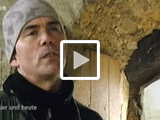 |
       |  |
zurück zur Übersicht
|
Photonews April 2004 Andreas Magdanz Auschwitz-Birkenau Hommage ŕ Marceline Loridan-lvens by Peter Lindhorst Opened it, put it aside, tiptoed around it, pulled it out again. The little, friendly looking book by Andreas Magdanz, adorned with its inviting cover resplendent with white marguerites on a dark green. The camera dives deeply into the field of flowers. The detailed shot of the ground provides for a high degree of abstraction. The view onto a rambling idyll is intentionally narrowed. It is accompanied by the observer's ignorance as to the whereabouts of the location shown. The rampant idyll displayed on the cover is perpetuated in Magdanz' work on Auschwitz-Birkenau. The gaze is drawn from the detailed shot towards the long shot. The marguerites reappear on meadows in bloom and between shady birch groves. Young foxes play in the warm sunlight, a pond rests quietly in the midst of a small wood. These seem to be the most remote of all places, whose unspoiledness seems to be contradicted by the remaining stone testimonies to an erstwhile efficient machinery of death: barracks, smokestacks, watchtowers, barbed wire. The observer's innocence crumbles to pieces when Magdanz confronts it with pictures of the blown-apart crematoria or inside shots of the barracks and of the so-called »sauna«. But it is mainly the »sunlit views« that make the observer's blood run cold. That outrageous sentence from the novel »Fateless« forces itself into my mind: »In spite of any other consideration, rational thought, insight or sobriety of mind - I couldn't mistake the furtive words of some kind of quiet desire stubbornly rising from within myself, as if embarrassed by their stubbornness; I would so like to live a little longer in this beautiful concentration camp.« In Imre Kertesz' highly recommendable novel, the reader is being plunged into the world of the death camps together with fifteen-year-old György. He witnesses the naivety of the protagonist who has been torn away from his childhood. Deportation, selection, labour camps and grave illness form the various stages of the story. At the end, he is freed and returns to Hungary, only to be met with hostility. The conflicting emotions of a survivor become evident when he suddenly experiences something akin to a belated homesickness. Might something similar to happiness lie between those smokestacks? In connection with the Franco-German film »Birkenau und Rosenfeld« due to be shown in the cinemas shortly, Mr Magdanz was asked whether he could envision a work of photography about the Auschwitz-Birkenau camp. It took her whole life for Marceline Loridan-lvens, who is a maker of documentaries and a survivor of the Holocaust, to be able to make a film out of her traumatic experiences during the Holocaust. She chose to make it a work of fiction, even though she usually produces documentaries. Anouk Aimee plays Myriam, Ms Loridan-lvens' alter ego, who finally dares to visit Auschwitz after more than fifty years have passed. There, she meets the young German Oskar whose grandfather took part in those crimes, and who takes photographs in Auschwitz »to show the invisible«. He asks her to help him find traces of the past. Myriam is filled with indignation at the idea that, of all people, a young German chooses to disturb her journey back to the place of her suffering. While they look around the concentration camp together, something like trust evolves between these two people of different ages and different backgrounds. Mr Magdanz has also visited the camp together with the director: the sidings of the railway tracks, the barracks, the crematoria, the lakes filled with human ashes, the rooms in which the belongings of the victims were stored, the ramp, the main entrance gate. After the film crew had left, he staid on to take photographs at these places. It was his task to take photos which would be shown in the film again and again as the results of Oskar's work. Out of this work arose a concentrated book in small format whose pictures are at the same time narrative as well as hard to handle. Mr Magdanz uses colour, which sets this book apart from other works dealing with the same topic, and which makes it appear more radical. Its impact arises from the shortening of the distance between the observer and the subject by means of colours. The events seem to be more present, while black-and-white is seen more as a means of setting the stage and is in jeopardy of congealing into a symbol of the past. The horror is then associated with a distant world which exists within strict boundaries, thus presenting the observer with the opportunity to remain untouched by the events. May an orange evening sky form the backdrop to the watchtower at the ramp? May the wet path from the sidings to the camp sparkle in a fascinating violet? May something akin to beauty be shown to exist between the smokestacks? Nobody should get the wrong idea: no taboos are being broken, nor is anything being shrouded in mystery, which would entail playing down the events. Nature is not being staged as a reconciliatory place , it is just found like that by Mr Magdanz. The photographer shows the visible, while at the same time, we give substance to the invisible behind it. Just as in Kertesz' first-person narrator, conflict arises in the observer, too, when fascination gives way to unbearable discomfort and vice versa. These meditative images take one's breath away until one is slowly strangled by them. The real experience of this book is this: to contemplate the pictures is an exercise in extreme self-observation. It hurts. |
|||||||||||||||||||||
| aktuelles andreas magdanz arbeiten neue projekte magbooks presse lehre kontakt impressum | english | ||

